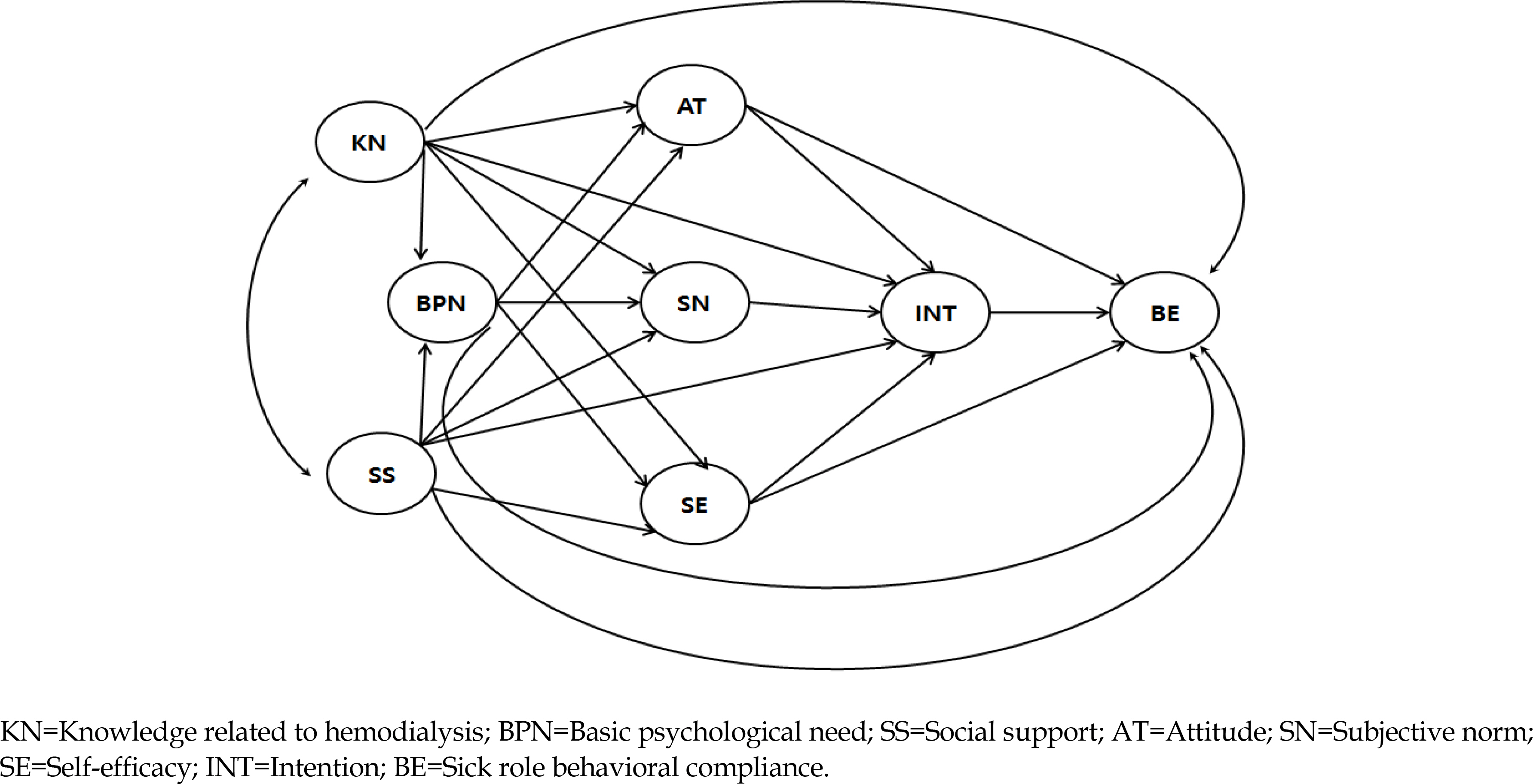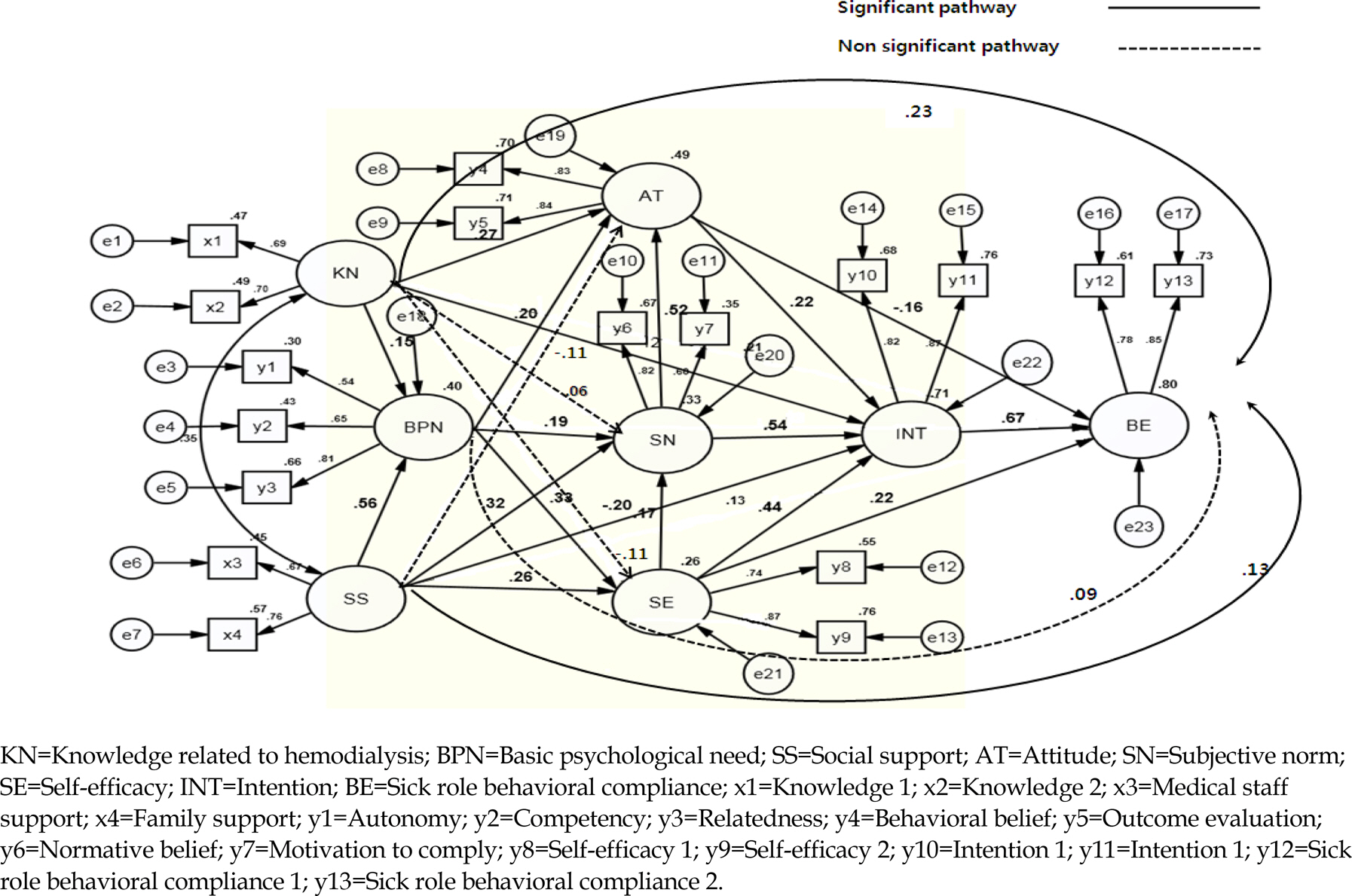Korean J Adult Nurs.
2016 Aug;28(4):415-423. 10.7475/kjan.2016.28.4.415.
A Structural Analysis for Psychosocial Variables related to Sick Role Behavioral Compliance in Hemodialysis Patients
- Affiliations
-
- 1Department of Nursing, Dongshin University, Naju, Korea. cymun@hanmail.net
- KMID: 2351405
- DOI: http://doi.org/10.7475/kjan.2016.28.4.415
Abstract
- PURPOSE
This study was designed to identify the structural relationships among psychosocial variables related to sick role behavioral compliance among patients undergoing hemodialysis.
METHODS
The subjects were 476 patients from seven major hospitals and twelve dialysis centers located in D and P cities. Data were collected using self-report questionnaires. Data analysis was done by using SPSS/WIN 18.0 and AMOS 18.0 programs for structural equation modeling, to estimate the hypothesized model.
RESULTS
This findings support that a modified path model is efficient and appropriate to explain sick role behavioral compliance among hemodialysis patients. These factors account for 80.1% of the variance of sick-role behavioral compliance among hemodialysis patients. The variables having direct effect on sick role behavioral compliance were knowledge related to hemodialysis, social support, attitude, self-efficacy and intention.
CONCLUSION
The modified model explains the integration process of psychosocial and behavior variables for sick-role behavioral compliance among patients undergoing hemodialysis.
Figure
Reference
-
1.The Korean Society of Nephrology. Current renal replacement therapy in Korea [Internet]. Seoul: ESRD Registry Committee, Korean Society of nephrology;2013. [cited 2016 April 20]. Available from:. http://www.ksn.or.kr/journal/2014/index.html.2.An GJ. Effects of self-care program using SMS, e-mail, or telephone call on self-care compliance and nutritional status in hemodialysis patients. Journal of Korean Biological Nursing Science. 2009. 11(2):157–66.3.Leggat JE Jr. Adherence with dialysis: a focus on mortality risk. seminars in dialysis. 2005. 18(2):137–41. http://dx.doi.org/10.1111/j.1525-139X.2005.18212.x.4.Baines LS., Jindal RM. Non-compliance in patients receiving haemodialysis: an in-depth review. Nephron. 2000. 85:1–7. http://dx.doi.org/10.1159/000045622.
Article5.Moon ES. A structural analysis of the social-motivational variables influencing adolescents' school dropout behavior. The Korean Journal of Educational Psychology. 2006. 20(2):405–23.6.Choi SB., Ham KS. The relationships between social support, basic needs and quality of life in leisure participation by old adults. Journal of Sport and Leisure Studies. 2009. 38:671–82.
Article7.Cho YM., Choi MS., Sung KW. Factors predicting sick role behavioral compliance in hemodialysis patient. Korean Journal of Adult Nursing. 2011. 23(3):235–43.8.Choe MA., Hah YS., Kim KS., Yi MS., Choi JA. A study on exercise behavior, exercise environment and social support of middle-aged women. Journal of Korean Academy of Nursing. 2008. 38(1):101–10.
Article9.Kim KH. A study on influencing factors to the quality of life of the hemodialysis patients.[master's thesis]. Seoul: Kyunghee University;1996.10.Na DM., Lee KO., Song ES. Relationship between the knowledge of hemodialysis and the compliance of patient role behavior in hemodialysis patients. The Medical Journal of Chosun University. 2004. 29(3):12–20.11.Tsay SL. Self-efficacy training for patient with end-stage renal disease. Journal of Advanced Nursing. 2003. 43(4):370–5.12.Hong KY. A study of the relationships among dialysis related knowledge, self efficacy and compliance of patient role behavior in hemodialysis patients. [master's thesis]. Seoul: Hanyang University;1999.13.Cho YM., Sung KW. The association of compliance with sick role behavior with satisfaction of basic psychological needs among hemodialysis patients. Korean Journal of Health Promotion. 2012. 12(1):58–65.14.Lee MR. Testing a motivational sequence integrated self-determination theory and the theory of planned behavior: focused on dieting behavior. Korean Journal of Health Psychology. 2014. 19(1):443–51.15.Hagger MS., Chatzisarantis NLD. The trans-contextual model of motivation. Hagger MS, Chatzisarantis NLD, editors. Intrinsic motivation and self-determination in exercise and sports. Champaign, IL: Human Kinetics;2007. p. 53–70.
Article16.Hagger MS., Chatzisarantis NLD., Harris J. From psychological need satisfaction to intentional behavior: testing a motivational sequence in two behavioral contexts. Personality and Social Psychological Bulletin. 2006. 32:131–8. http://dx.doi.org/10.1177/0146167205279905.
Article17.Hagger MS., Chatzisarantis NLD., Hein V., Soos I., Karsai I., Lintunen T, et al. Teacher, peer and parent autonomy support in physical education and leisure-time physical activity: a trans-contextual model of motivation in four nations. Psychology and Health. 2009. 24(6):689–711. http://dx.doi.org/10.1080/08870440801956192.
Article18.Moon SB. Basic concepts and application of structural equation modeling with AMOS 17.0. Seoul: Hakjisa;2009.19.Ryan RM., Deci EL. An overview of self-determination theory. Deci EL, Ryan RM, editors. Handbook of self determination research. Rochester, NY: University of Rochester Press;2002. p. 3–33.20.Ajzen I. Constructing a TpB questionnaire: conceptual and methodological considerations. Revised January. 2006. [cited 2016 April 16]. Available from:. http://www.uni-bielefeld.de/ikg/zick/ajzen%20construction%20a%20tpb%20questionnaire.pdf.21.Jee YO. Instrument development for the application of the theory of planned behavior. Korean Journal of Nursing Query. 1994. 2(2):102–15.22.Kim JH. An effect of guided imagery applied to hemodialysis patients. [dissertation]. Seoul: Seoul National University;1995.23.Lee GH. The relationships between game knowledge, basic needs for physical education classes, and behavioral regulation among middle and high school students. Korean Journal of Sport Psychology. 2010. 21(1):99–110.24.Kim MJ. A structural equation model explaining contraception behaviors of married Korean women. Korean Journal of Women Health Nursing. 2001. 7(2):141–56.25.Park JK. Predicting adolescent´s intention for physical activity and behavior using the theory of planned behavior: The roles of family support and personality. Korean Journal of Sport Psychology. 2011. 22(1):129–44.26.Hagger MS., Chatzisarantis NLD. Self-determination theory and the promotion and maintenance of sport, exercise, and health. Hagger MS, Chatzisarantis NLD, editors. Intrinsic motivation and self-determination in exercise and sports. Champaign, IL: Human Kinetics;2007. p. 1–19.27.Austin GS., David RM. Association of patient autonomy with increased transplantation and survival among new dialysis patient in the United States. American Journal of Kidney Diseases. 2005. 45(4):730–42. http://dx.doi.org/10.1053/j.ajkd.2004.12.016.28.Kim SH., Lee SH. Influences of knowledge, self-efficacy, and social support on sick role behavior in patients with coronary artery disease. Journal of Korean Public Health Nursing. 2014. 28(2):228–40. http://dx.doi.org/10.5932/JKPHN.2014.28.2.228.
Article
- Full Text Links
- Actions
-
Cited
- CITED
-
- Close
- Share
- Similar articles
-
- Factors Predicting Sick Role Behavioral Compliance in Hemodialysis Patients
- The Association of Compliance with Sick Role Behavior with Satisfaction of Basic Psychological Needs Among Hemodialysis Patients
- Factors Influencing Sick Role Behavior Compliance in Patients on Hemodialysis
- A Study on the Relationship of Perceived Self-efficacy and Sick-role behavioral Compliance in Diabetic children
- Sick-role Behavioral Compliance and Influencing Factors in Patients with Diabetes



